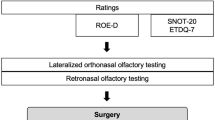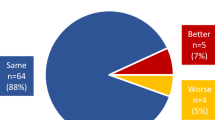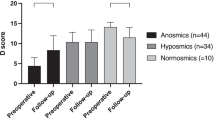Abstract
Olfactory dysfunction is a frequent symptom of nasal and sinunasal disease. Many of these patients undergo nasal sinus or nasal septum surgery. In this study, we evaluated the benefit of nasal surgery on olfactory function over a period of 12 months. Patients included in this study underwent either nasal sinus or nasal septum surgery. All patients were tested for olfactory function using the “Sniffin’ sticks” 16 item odor identification test. In addition, patients were asked to rate their nasal patency as well as their olfactory function at each visit. 157 patients were tested 3.5 months after surgery and 52 patients were tested again 12 months after surgery. Olfactory function improved significantly 3.5 months after surgery in patients, who received nasal sinus surgery; no significant increase was found in patients treated with nasal septum surgery. At the 12-month follow-up, the increase in olfactory function over all patients just missed statistical significance. Individually, however, 19% of the patients exhibited improvement after 3.5 months and 17% after 12 months. These numbers increased in patients with rhinosinusitis with nasal polyps, who exhibited improvement of 30% after 3.5 months, and 32% after 12 months. Nasal sinus surgery produced an increase in measured olfactory function, but not nasal septum surgery. This increase appeared to be stable over the examined period of 12 months.



Similar content being viewed by others
References
Doty RL (1991) Olfactory capacities in aging and Alzheimer’s disease. Psychophysical and anatomic considerations. Ann N Y Acad Sci 640:20–27
Damm M, Temmel A, Welge-Lussen A et al (2004) Olfactory dysfunctions. Epidemiology and therapy in Germany, Austria and Switzerland. HNO 52:112–120
Litvack JR, Mace J, Smith TL (2009) Does olfactory function improve after endoscopic sinus surgery? Otolaryngol Head Neck Surg 140:312–319
Pade J, Hummel T (2008) Olfactory function following nasal surgery. Laryngoscope 118:1260–1264
Danielides V, Katotomichelakis M, Balatsouras D et al (2009) Evaluation of prognostic factors for olfaction in nasal polyposis treated by endoscopic sinus surgery. Rhinology 47:172–180
Bonfils P, Malinvaud D, Soudry Y, Devars du Maine M, Laccourreye O (2009) Surgical therapy and olfactory function. B-ENT 5(Suppl 13):77–87
Perry BF, Kountakis SE (2003) Subjective improvement of olfactory function after endoscopic sinus surgery for chronic rhinosinusitis. Am J Otolaryngol 24:366–369
Landis BN, Hummel T, Hugentobler M, Giger R, Lacroix JS (2003) Ratings of overall olfactory function. Chem Senses 28:691–694
Delank KW, Stoll W (1998) Olfactory function after functional endoscopic sinus surgery for chronic sinusitis. Rhinology 36:15–19
Olsson P, Stjarne P (2010) Endoscopic sinus surgery improves olfaction in nasal polyposis, a multi-center study. Rhinology 48:150–155
Hummel T, Sekinger B, Wolf SR, Pauli E, Kobal G (1997) “Sniffin’ sticks”: olfactory performance assessed by the combined testing of odor identification, odor discrimination and olfactory threshold. Chem Senses 22:39–52
Hummel T, Kobal G, Gudziol H, Mackay-Sim A (2007) Normative data for the “Sniffin’ Sticks” including tests of odor identification, odor discrimination, and olfactory thresholds: an upgrade based on a group of more than 3,000 subjects. Eur Arch Otorhinolaryngol 264:237–243
Gudziol V, Lotsch J, Hahner A, Zahnert T, Hummel T (2006) Clinical significance of results from olfactory testing. Laryngoscope 116:1858–1863
Federspil PA, Wilhelm-Schwenk R, Constantinidis J (2008) Kinetics of olfactory function following endonasal sinus surgery for nasal polyposis. Rhinology 46:184–187
Minovi A, Hummel T, Ural A, Draf W, Bockmuhl U (2008) Predictors of the outcome of nasal surgery in terms of olfactory function. Eur Arch Otorhinolaryngol 265:57–61
Konstantinidis I, Witt M, Kaidoglou K, Constantinidis J, Gudziol V (2010) Olfactory mucosa in nasal polyposis: implications for FESS outcome. Rhinology 48:47–53
Konstantinidis I, Triaridis S, Printza A, Vital V, Ferekidis E, Constantinidis J (2007) Olfactory dysfunction in nasal polyposis: correlation with computed tomography findings. ORL J Otorhinolaryngol Relat Spec 69:226–232
Philpott CM, Rimal D, Tassone P, Prinsley PR, Premachandra DJ (2008) A study of olfactory testing in patients with rhinological pathology in the ENT clinic. Rhinology 46:34–39
Damm M, Eckel HE, Jungehulsing M, Hummel T (2003) Olfactory changes at threshold and suprathreshold levels following septoplasty with partial inferior turbinectomy. Ann Otol Rhinol Laryngol 112:91–97
Pfaar O, Huttenbrink KB, Hummel T (2004) Assessment of olfactory function after septoplasty: a longitudinal study. Rhinology 42:195–199
Downey LL, Jacobs JB, Lebowitz RA (1996) Anosmia and chronic sinus disease. Otolaryngol Head Neck Surg 115:24–28
Lund VJ, MacKay IS (1994) Outcome assessment of endoscopic sinus surgery. J R Soc Med 87:70–72
Ehnhage A, Olsson P, Kolbeck KG et al (2009) Functional endoscopic sinus surgery improved asthma symptoms as well as PEFR and olfaction in patients with nasal polyposis. Allergy 64:762–769
Kimmelman CP (1994) The risk to olfaction from nasal surgery. Laryngoscope 104:981–988
Leopold DA (1988) The relationship between nasal anatomy and human olfaction. Laryngoscope 98:1232–1238
Damm M, Vent J, Schmidt M et al (2002) Intranasal volume and olfactory function. Chem Senses 27:831–839
Zhao K, Scherer PW, Hajiloo SA, Dalton P (2004) Effect of anatomy on human nasal air flow and odorant transport patterns: implications for olfaction. Chem Senses 29:365–379
Conflict of interest
None of the authors declares a conflict of interest.
Author information
Authors and Affiliations
Corresponding author
Rights and permissions
About this article
Cite this article
Schriever, V.A., Gupta, N., Pade, J. et al. Olfactory function following nasal surgery: a 1-year follow-up. Eur Arch Otorhinolaryngol 270, 107–111 (2013). https://doi.org/10.1007/s00405-012-1972-0
Received:
Accepted:
Published:
Issue Date:
DOI: https://doi.org/10.1007/s00405-012-1972-0




